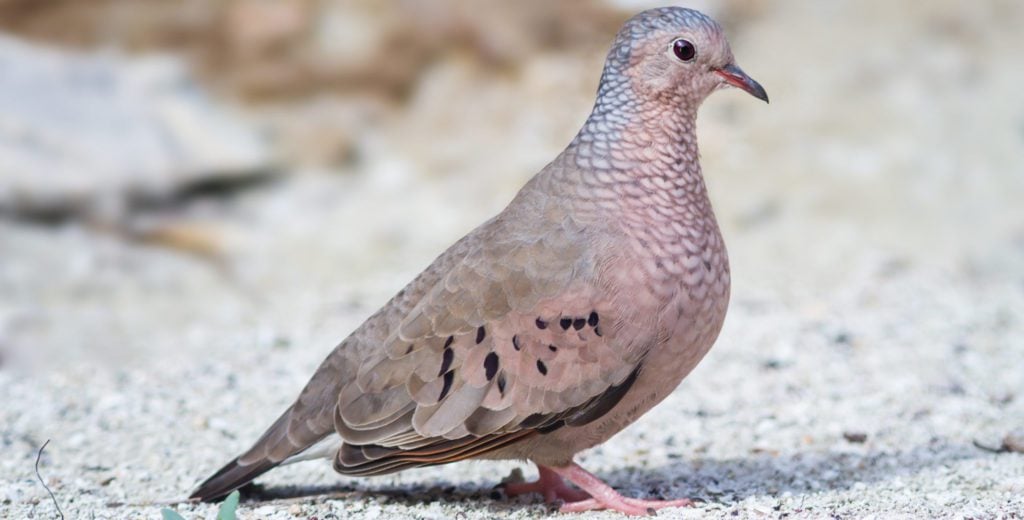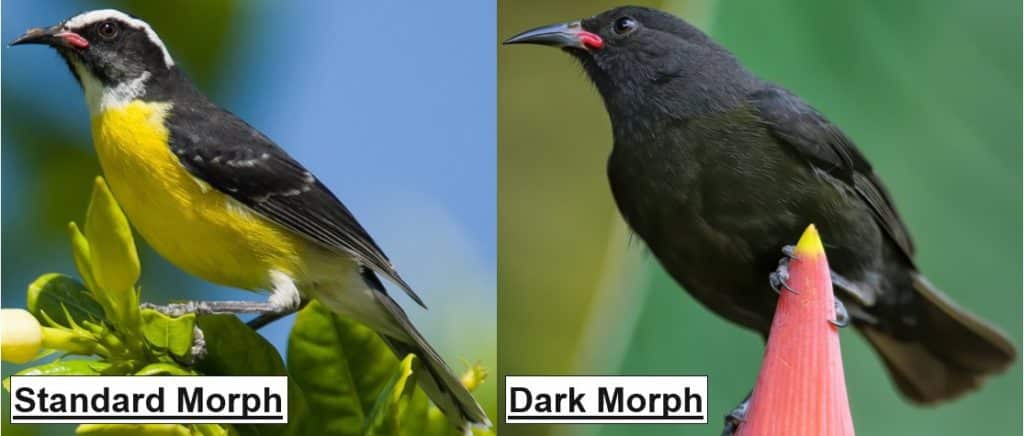9 Types of BIRDS Found on Aruba! (COMMON)
Below you will find 9 COMMON BIRDS that live in Aruba!

Believe it or not, over 250 species have been observed here, including many birds that only visit during migration. Because of the incredible variety, it would be impossible to list EVERY single type below.
So I did my best to come up with a list of the birds that are seen the MOST. Enjoy! 🙂
Common Birds of Aruba:
#1. Ruddy Turnstone
- Arenaria interpres

Identifying Characteristics:
- Breeding males have a chestnut and black pattern on the back, similar to a calico cat.
- They have orange legs, which are brighter during the breeding season.
Ruddy Turnstones occupy different habitats each season. They nest along rocky coasts in the Arctic during the breeding season. While migrating, they visit plowed fields and shorelines of lakes. Finally, they congregate on rocky shorelines and beaches in the winter.
These beautiful shorebirds have a unique feeding style that earned them their name. They insert their bills under stones, shells, and other objects, flipping them over to find food underneath. Several Ruddy Turnstones may work together to flip a large object.
They will also probe under seaweed and other debris. Their low center of gravity and special feet with short, sharply curved toenails allow them to walk easily on wet and slippery rocks. WATCH BELOW!

#2. Laughing Gull
- Leucophaeus atricilla

Identifying Characteristics:
- Adults range from 39-46 cm (15.3-18.1 in) in length and have a 92-120 cm (36.2-47.2 in) wingspan.
- Adults are medium gray above and white below with reddish-black legs.
- Summer adults have a crisp black hood, white arcs around the eyes, and reddish bills, and in winter, the hood becomes a blurry gray mask on a white head.
Laughing Gulls are typically spotted in Aruba in coastal areas like beaches, salt marshes, and mangroves.
Like many other gulls, Laughing Gulls are adept at foraging while walking, wading, swimming, or flying. Their food sources include crustaceans, insects, squid, human refuse, berries, fish, earthworms, snails, and the eggs of horseshoe crabs.
These gulls steal food from Brown Pelicans by landing on their heads and taking fish from their bill pouch. I’m sure the Brown Pelicans aren’t laughing when that happens!

#3. Caribbean Flamingo
- Phoenicopterus ruber

Also known as the American Flamingo.
Identifying Characteristics:
- Reddish-pink plumage.
- They measure from 120 to 145 cm (47 to 57 in) tall.
- The bill is white and pink with a large black tip.
These large birds are unmistakable in Aruba!
The best places to find Caribbean Flamingoes are in shallow, saline lagoons. Like all flamingoes, they have a specialized beak, which is hooked downward, perfect for finding and filtering food in these habitats. Some common food items include small crustaceans, mollusks, some worms, nematodes, insects and their larvae, small fish, etc.
Despite their beauty, Caribbean Flamingoes sound just like geese! Listen below:
#4. Common Ground Dove
- Columbina passerina

Identifying Characteristics:
- These doves are small, being only slightly larger than a sparrow!
- They have a plain grey-brown back. The underparts have a pinkish tint to them.
- Small heads with a scaled pattern on their breast and neck. Dark spots on the wings.
Common Ground Doves are typically easy to find in Aruba. Look for them feeding on the ground beneath bird feeders, cleaning up the grains and other seeds that fall from above.
These doves primarily nest on the ground! Simple nests are built lined with a few types of grass, weeds, and other plant matter. Being on the ground, they can make an easy meal for many predators. Their primary defense is to blend into their surroundings and thick vegetation.
Common Ground Doves are relatively vocal. They can be heard at all times of the day and at any time of the year. Listen for a repeated, soft, high-pitched coo with a rising inflection.
#5. Brown Pelican
- Pelecanus occidentalis

Identifying Characteristics:
- Brown skin on their giant throat patch.
- Dark gray bodies with a white neck and pale yellow head.
- Measures 3.5 – 5 feet in length (1 to 1.5 m) with a wingspan of 6.5 – 7.5 feet (2 to 2.3 m). The weight of adults can range from 4.4 to 11.0 lb (2 to 5 kg).
If you see a pelican in Aruba while sitting on a beach, it is most likely a Brown Pelican. These large birds live strictly in saltwater habitats near the ocean’s coastline. Interestingly, they rarely venture into the open ocean, staying within 20 miles of the shore.
It’s a lot of fun watching Brown Pelicans hunting for fish! First, they fly high into the sky and then plunge aggressively headfirst into the water. These dives are meant to stun the surrounding fish, which then are scooped up with their enormous throat pouch and swallowed whole.
Check out the below video to learn more about their insane dives!

And lastly, they birds live a long time. The oldest Brown Pelican on record was 43 years of age!
#6. Bananaquit
- Coereba flaveola

Identifying Characteristics:
- Adults range from 10-13 cm (4-5 in) long.
- Most adults have dark gray upperparts, a black crown, and a yellow chest, belly, and rump.
Bananaquits have something in common with many humans I know – a sweet tooth! Also known as “sugar birds” in Aruba, this species is attracted to nectar feeders and bowls of sugar. They even enter homes looking for sweet treats.
Bananaquits are small, colorful, and known for adapting easily to human habitats. They like fruit and nectar, so they spend a lot of time near humans near flower gardens or fruit trees.
This species’ reliance on humans doesn’t stop with their diet. They often build their nests on human-made objects, including lampposts and garden trellises. Look for a globe-shaped tangle of sticks and leaves between 5 and 30 feet (1.5 to 9 m) off the ground.
#7. Magnificent Frigatebird
- Fregata magnificens

Identifying Characteristics:
- Long, narrow wings with a deeply forked tail.
- Males have a red throat patch, which is easily seen during the breeding season.
- Females have a white breast patch.
As the name implies, seeing these seabirds soaring effortlessly in the sky is quite “magnificent.” Using their forked tails to steer, they barely have to flap to stay afloat in the sky.
Due to the fact that their feathers are not waterproof like other seabirds, Magnificent Frigatebirds rarely land in the water and spend almost their entire lives flying. For food, they commonly steal fish from other birds or harass them until they regurgitate their meal, which they grab in midair! Their pirating ways have earned frigatebirds the nickname the “man-o-war bird.”
With Magnificent Frigatebirds, the “early bird” does not get the worm! Most individuals don’t take flight until later in the afternoon when thermals and winds are at their greatest. 🙂
#8. Carib Grackle
- Quiscalus lugubris

Identifying Characteristics:
- Males are glossy black.
- Females are dark grayish-brown.
- Both sexes have yellow eyes and pointed bills.
Like other types of grackles, this species is bold and can become very tame. It’s common to see Carib Grackles near people hoping to secure leftover food, even stealing items left unattended! These birds are especially abundant in Aruba in cities near the coast.
Carib Grackles are highly gregarious, and it’s rare to see just one of them. They do everything from foraging for food together to roosting at night in colonies.
#9. Tropical Mockingbird
- Mimus gilvus

Identifying Characteristics:
- Adults range from 23-25 cm (9-10 in) inches long.
- Their coloration is silvery-gray above and whitish below, with a long black tail.
- They have white stripes above their eye, long dark legs, and a slim, black beak with a slight downward curve.
Tropical Mockingbirds prefer open habitats in Aruba and avoid dense forests and mangroves. This species typically forages on the ground or in low vegetation. However, they may also perch and fly to catch insects like swarming termites.
These vocal birds are susceptible to parasitism by the Shiny Cowbird. Cowbirds lay their eggs in the Tropical Mockingbird’s nest, who then raises the chicks as their own. But, they have developed a unique adaptation to help them survive. Because up to 80% of nests are parasitized during their first brood, Tropical Mockingbirds lay second and third broods that aren’t affected.
Despite the name mockingbird, this species rarely mimics other birds. However, they often sing through the night and have various songs and calls.

Which of these birds have you seen before in Aruba?
Leave a COMMENT below! 🙂

